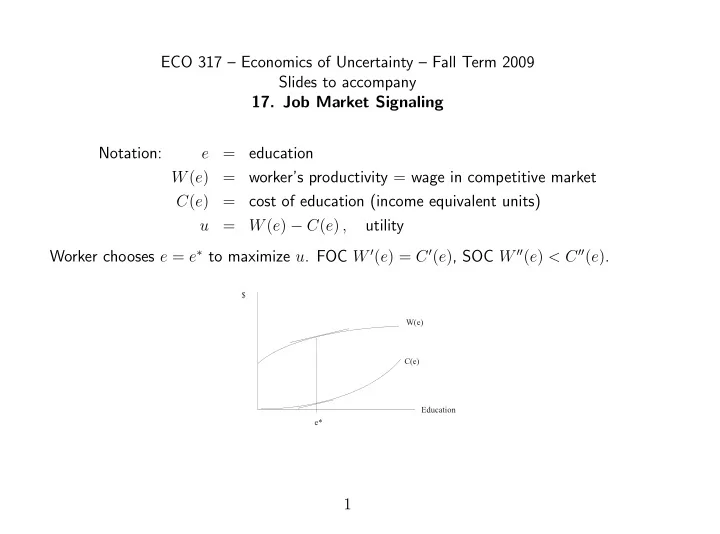

ECO 317 – Economics of Uncertainty – Fall Term 2009 Slides to accompany 17. Job Market Signaling Notation: = education e W ( e ) = worker’s productivity = wage in competitive market C ( e ) = cost of education (income equivalent units) u = W ( e ) − C ( e ) , utility Worker chooses e = e ∗ to maximize u . FOC W ′ ( e ) = C ′ ( e ) , SOC W ′′ ( e ) < C ′′ ( e ) . $ W(e) C(e) Education e* 1
Symmetric Information Benchmark Worker types 1 and 2; latter superior in all respects: For all e ; W 2 ( e ) > W 1 ( e ) , W ′ 2 ( e ) > W ′ 1 ( e ); C 2 ( e ) < C 1 ( e ) , C ′ 2 ( e ) < C ′ 1 ( e ) . W ′ 2 ( e ) − C ′ 2 ( e ) > W ′ 1 ( e ) − C ′ 1 ( e ) for all e is Mirrlees-Spence condition Under symmetric information, each type chooses e ; here e ∗ 2 > e ∗ 1 . $ W (e) 2 R L W (e) 1 K C (e) C (e) 1 2 Q J P H Education * * e e 1 2 2
Asymmetric Information Each applicant’s type is private information. Consider wage offer: � W 1 ( e ∗ 1 ) if e = e ∗ 1 w = W 2 ( e ∗ 2 ) if e = e ∗ 2 Type 1 wants to mimic Type 2 (get education e ∗ 2 ) if W 2 ( e ∗ 2 ) − C 1 ( e ∗ 2 ) > W 1 ( e ∗ 1 ) − C 1 ( e ∗ 1 ) . In figure, heights QR , JK almost equal, so could easily go either way. If mimicking, employers make losses; so the contract can’t prevail in equilibrium. Symmetric-information ideal may not be “incentive-compatible.” Note Type 2 does not want to mimic Type 1’s choice, because W 2 ( e ∗ 2 ) − C 2 ( e ∗ 2 ) > W 2 ( e ∗ 1 ) − C 2 ( e ∗ 1 ) > W 1 ( e ∗ 1 ) − C 2 ( e ∗ 1 ) ; In Figure 2, PR > HL (because e ∗ 2 is optimal for Type 2) and HL > HK. 3
To overcome Type 1’s temptation to mimic, and achieve separation of types, need higher level of education to establish Type 2. Try threshold E , and contract � W 1 ( e ∗ 1 ) if e ≥ E w = W 2 ( e ∗ 2 ) if e < E Condition for Type 1 not to mimic Type 2: W 1 ( e ∗ 1 ) − C 1 ( e ∗ 1 ) ≥ W 2 ( E ) − C 1 ( E ) , or E ≥ e s 2 (min) . Condition for Type 2 not to mimic Type 1 (not to give up): W 2 ( E ) − C 2 ( E ) ≥ W 1 ( e ∗ 1 ) − C 2 ( e ∗ 1 ) , or E ≤ e s 2 (max) . These bounds are illustrated in the figure on next page. Requiring E ≥ e s 2 (min) is the minimal unavoidable cost of achieving separation, but anything higher is inefficient. May be sustained in equilibrium by self-fulfilling expectations. 4
$ K " W (e) K ' 2 W (e) 1 K C (e) 1 C (e) 2 J ' H " J H Education s s * * e (max) e e e (min) 2 2 1 2 But experimentation may change expectations and achieve separation at lowest (informationally constrained efficient) signaling level. If the proportion of Type 1’s in the population is small, pooling at the average wage may be Pareto superior. 5
Recommend
More recommend